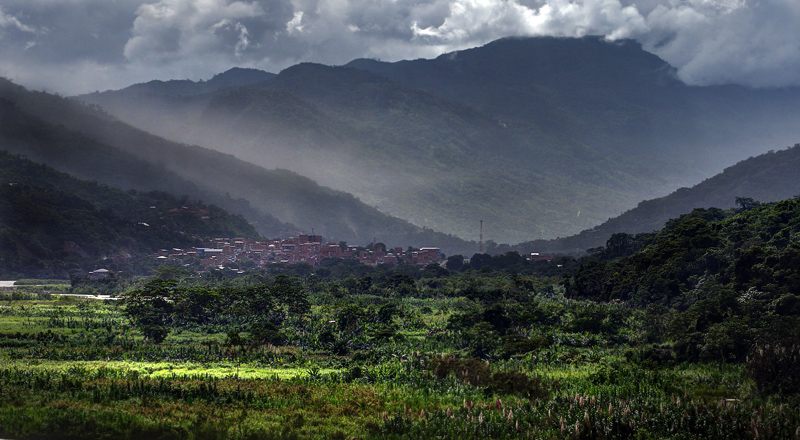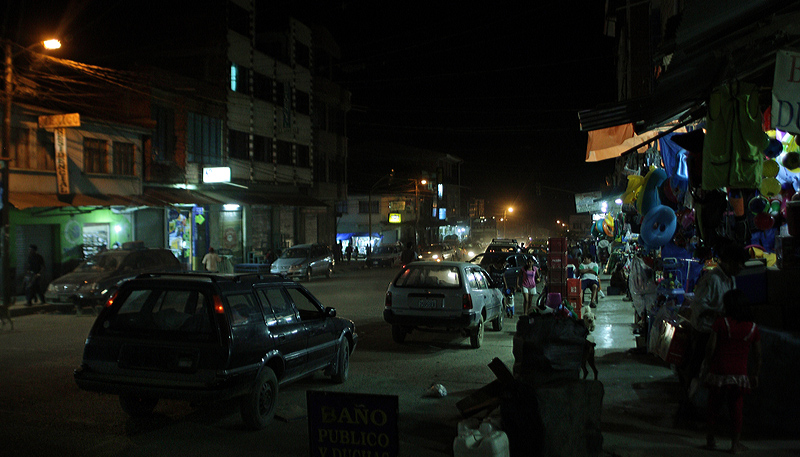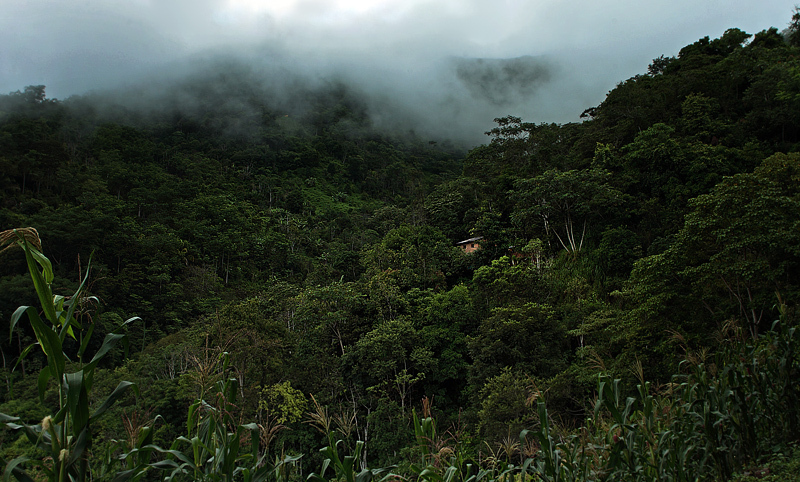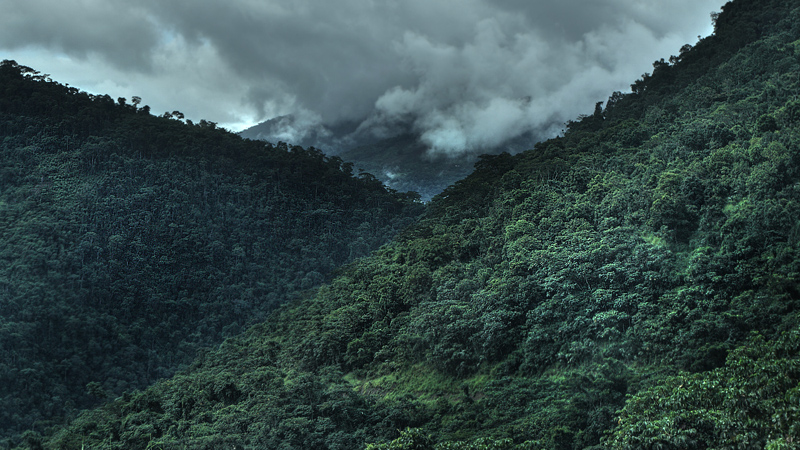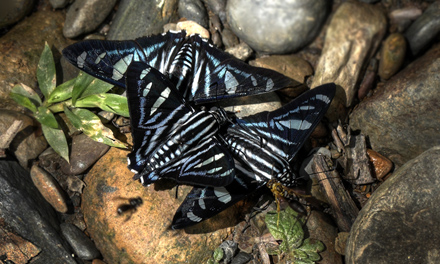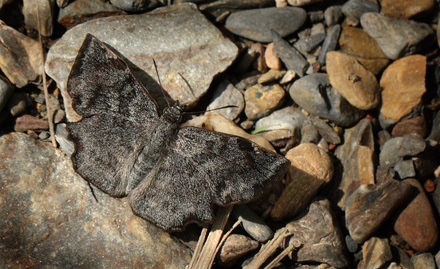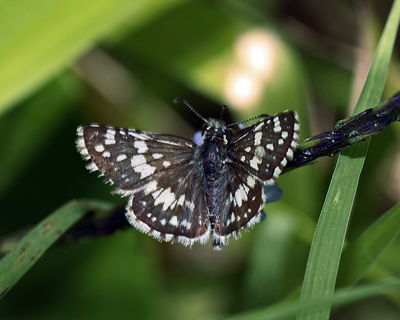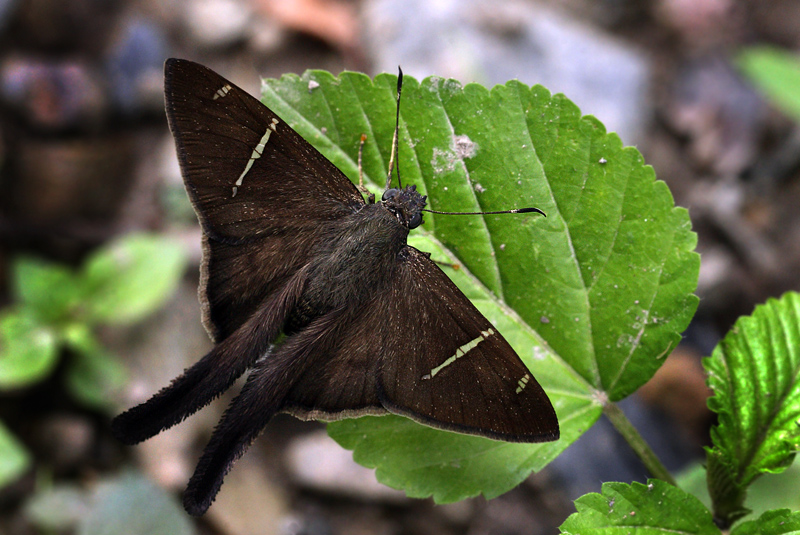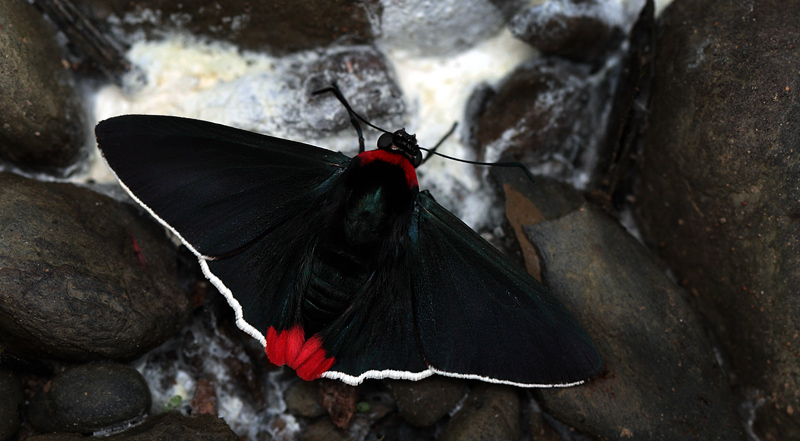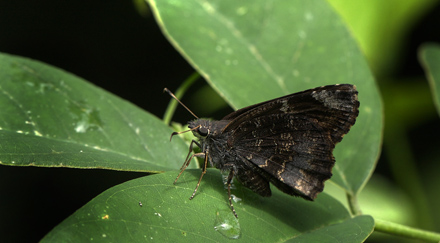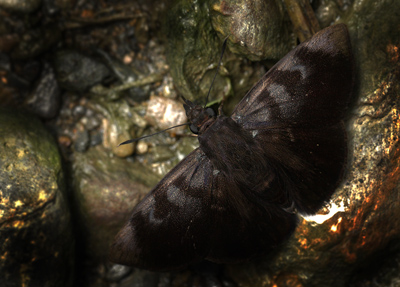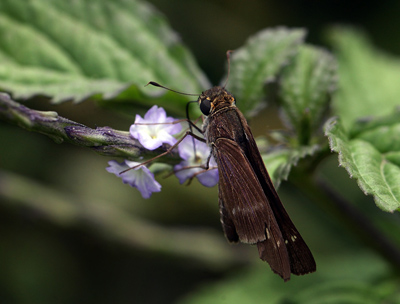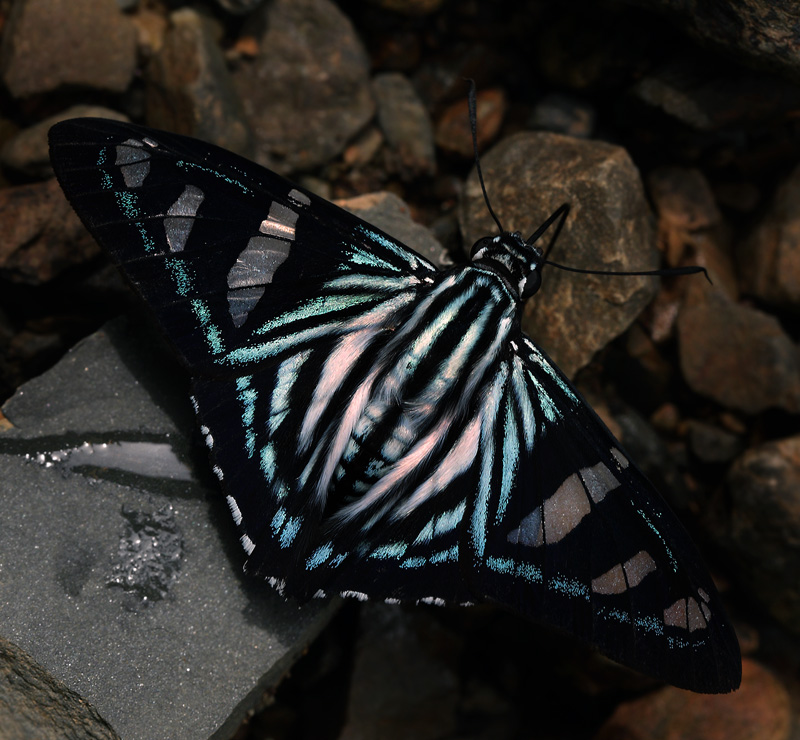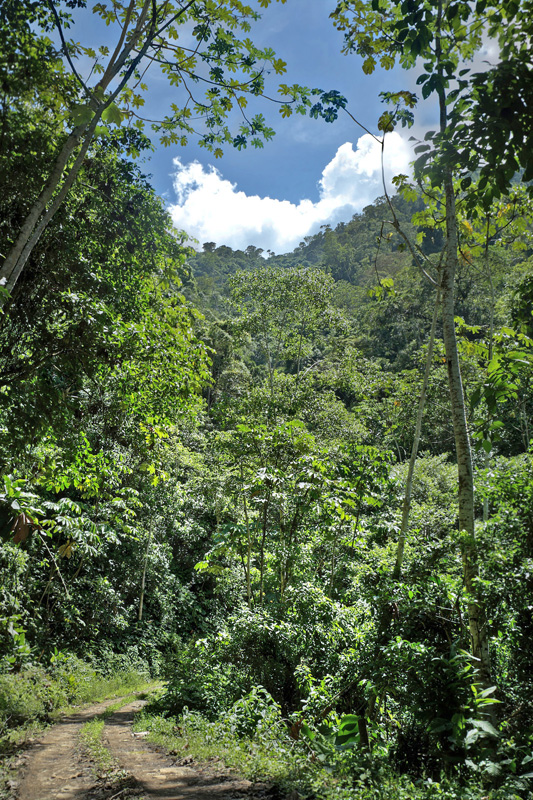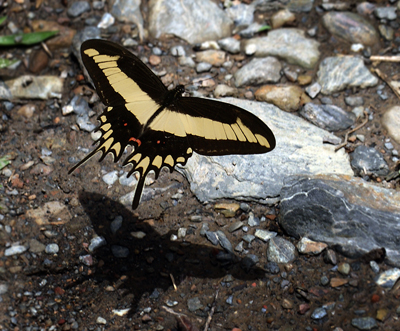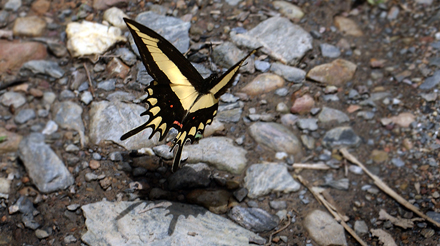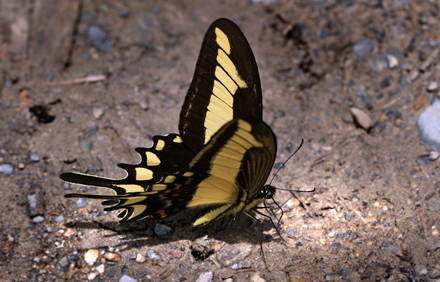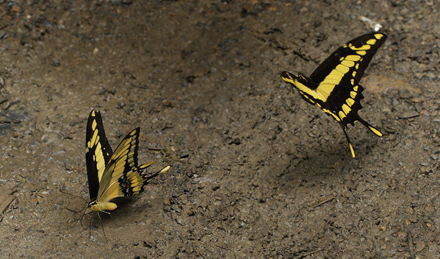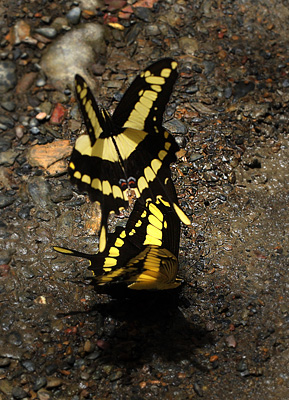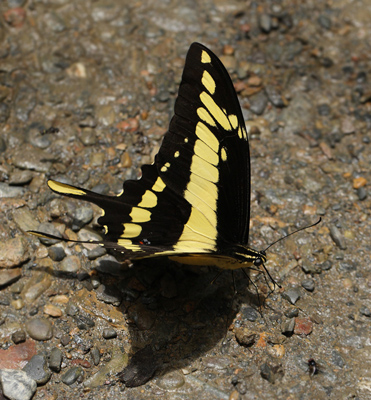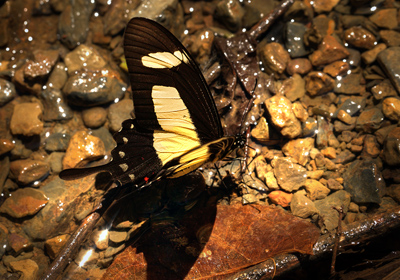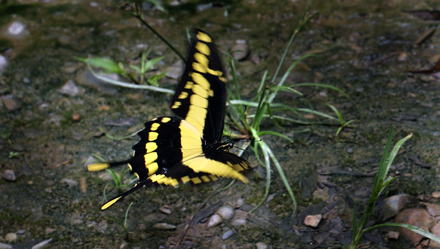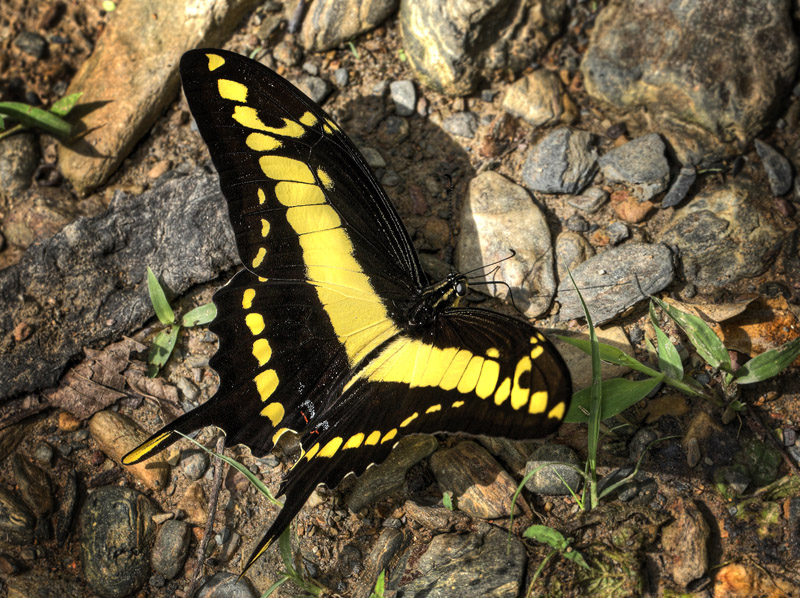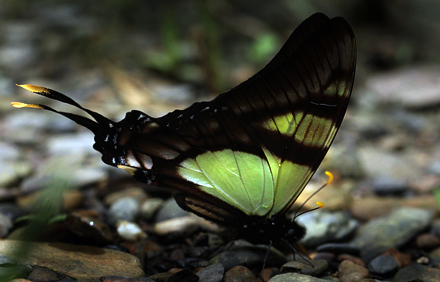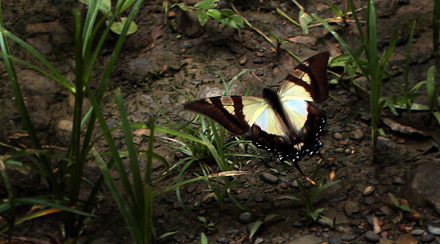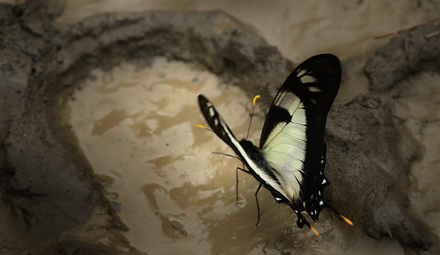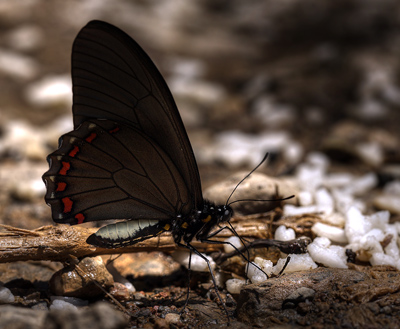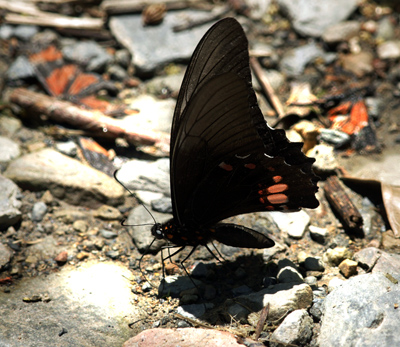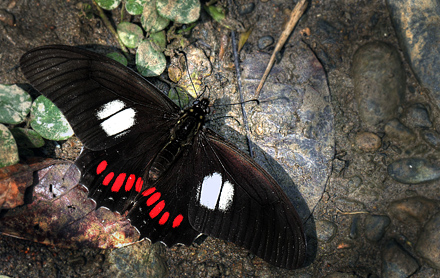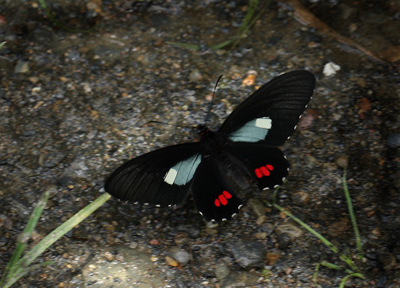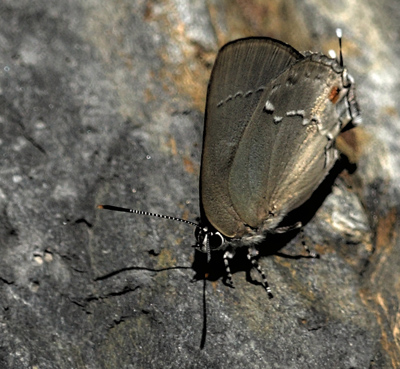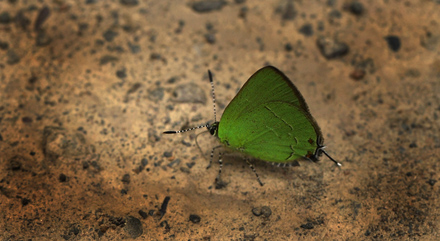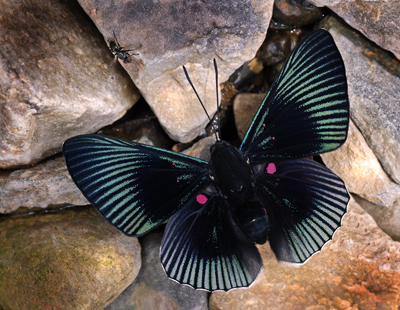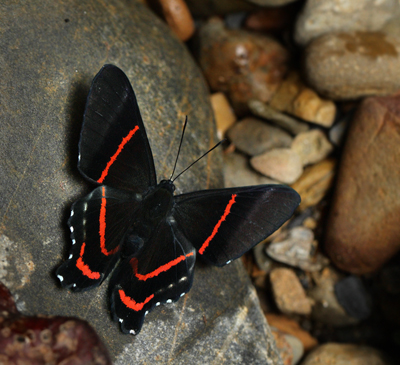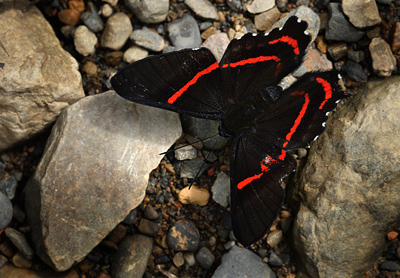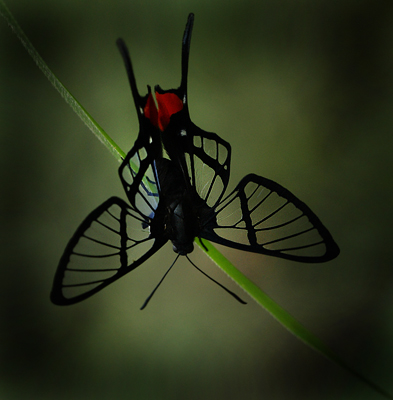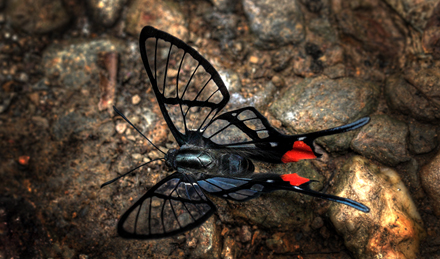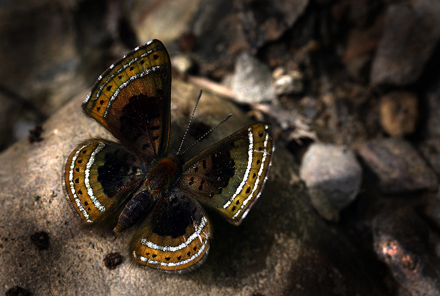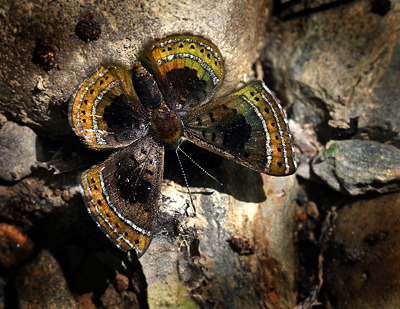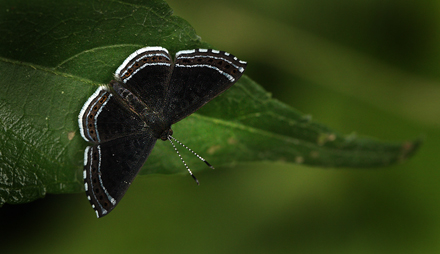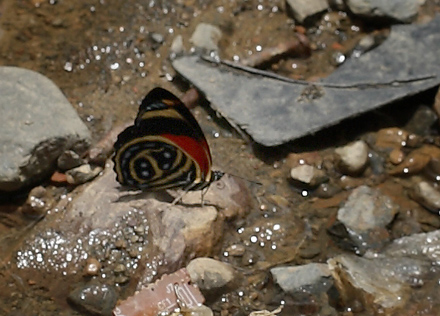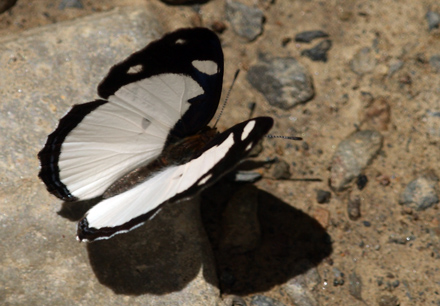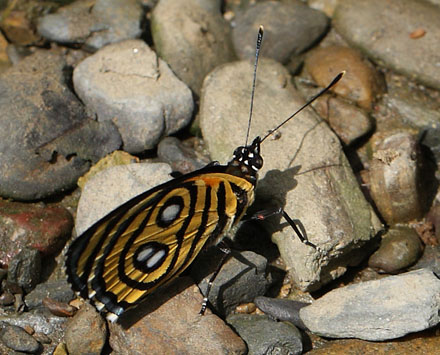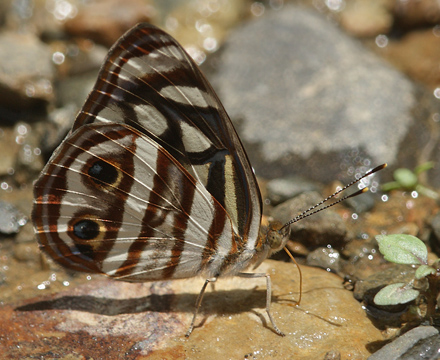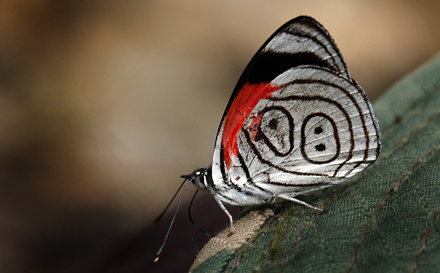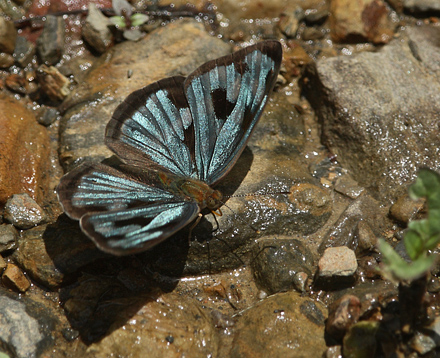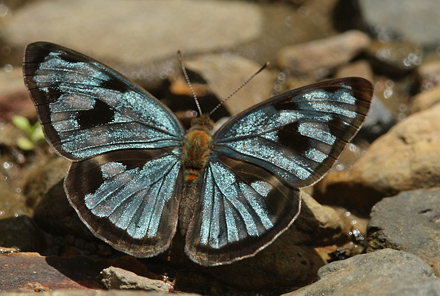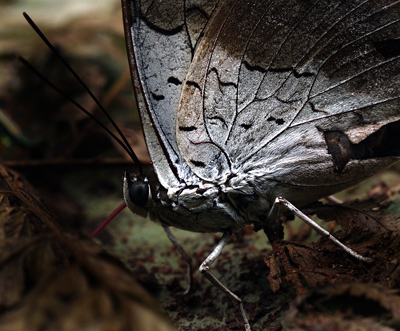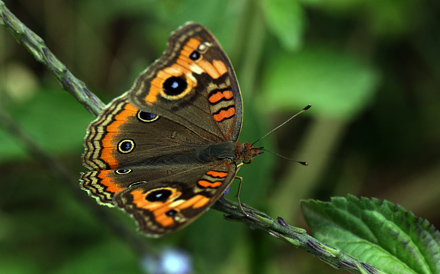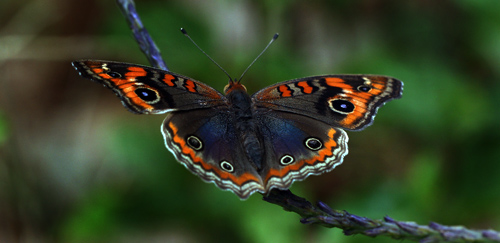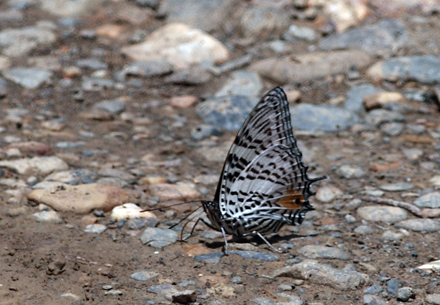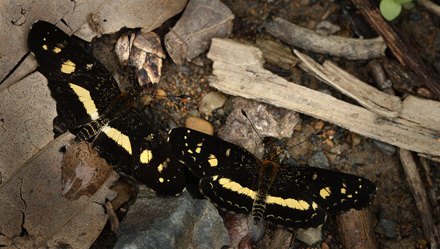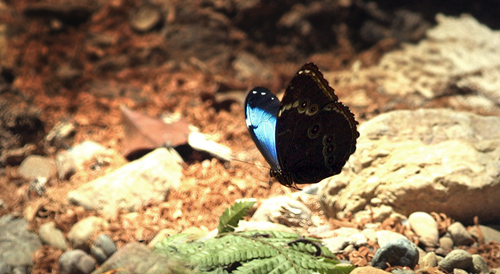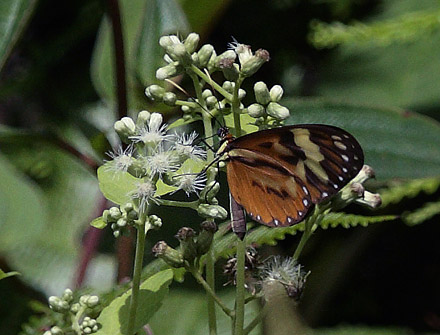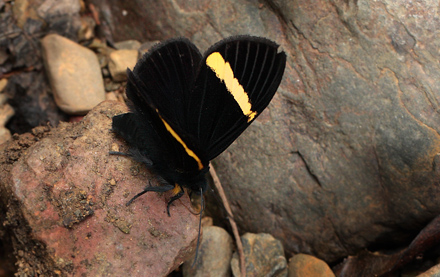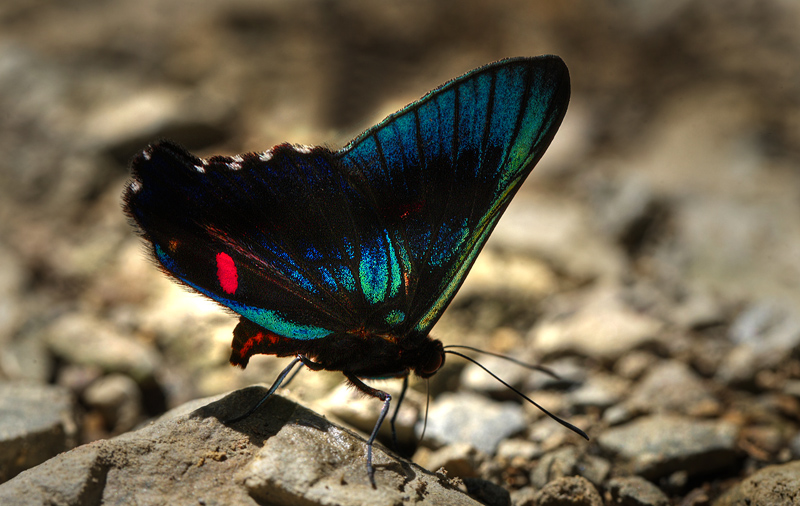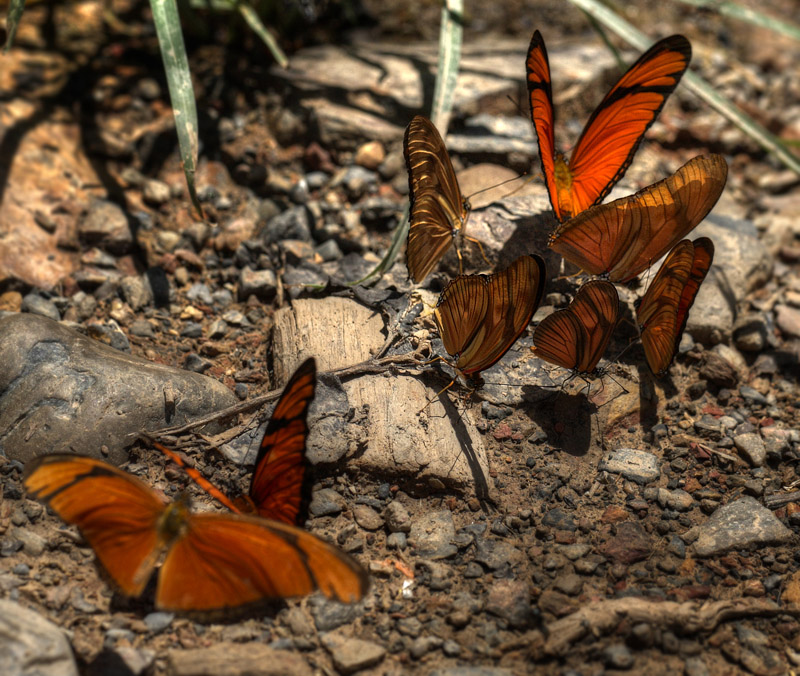MARIPOSAS de BOLIVIA
Enero - Febrero 2012
sitio 74
first update d. 8 March 2012
last update d. 21 January 2021
Redactor: Lars Andersen
bajo construccion
Caranavi valley, Yungas, elev. 500/900 m. part 1.
18 to 31 January 2012
Caranavi, Yungas, Bolivia January 2012 by Lars Andersen Caranavi region in the northern Yungas on the eastern Andean slopes, in valleys from 400 meters in Guarnay to Caranavi, 600 meters further to Yolosa at Coroico in the 1000 meters has a rich diversity of flora and fauna. The mountains around up to 1400 meters altitude also contains some species which are different than those lower down in the valleys, I suppose there are about 1500 to 1800 species of butterflies with Skippers family in Yungas. I myself have seen approx. half of these species over seven visits from the first time in January 2005, January 2006, February 2007, February 2008, February 2009, January 2010 and January 2012. Through the years I have formed an impression of the various butterfly populations in the area. Because in 2010 I started making BOLIVIAN BUTTERFLIES CHECKLIST. |
| Both in Coroico and Caranavi expands the small farming their fields, forests felled in particular coca fields that provide the most profitable profit. It can be seen on the wild fauna and flora are being reduced in thies region. From the first times I came into these valleys, there was a greater species richness than are now in 2012. And it was limited in what I saw of species that I had not seen before. One would far out into the woods to see some of the interesting butterflies. Or in a few ravines where they are so steep and deep that they can not be grown as found near Coroico. Here there are still unknown species. |
| I arrived in Caranavi 20th of January and moved into Jatata inn hotel, I met the owner Alfredo was really happy to see me. Unfortunately, their chef gone in anger for a little week ago, so there was only breakfast spot, and it was just a dry piece of bread, breakfast fruit juice and coffee. There I had even come with cheese and ham. Could it have been the guests who had provoked? But the hotel has an excellent pool and is situated slightly away from the busy main street down by the river Coroico. There is a garden surrounding the hotel where birds and butterflies flying around in the trees. |
| I was in Caranavi Valley in 10 days' time and visiting the numerous valleys and ravines in the area. I concentrated most on Skippers and Ringlet this time, and so very careful assembly during shooting and editing of photos in the different programs. I used my Canon EOS 1D Mark III with Canon 100 mm macro IS for most of the time. Sometimes I changed the lens Canon 300 mm. IS, L and Sigma 24 mm. Macro. As a reserve camera I had my old Canon EOS 20D with. Also had two small notebooks and some small travelharddisk. |
| On January 30 I traveled to Guarnay, but because of different road accidents on the road, I was delayed on the way, had from Alcoche take a taxi the rest of the way, and it is expensive. That meant I had to drop several days in the area when my cash was small, I did not expect to suddenly trip should cost so much. There had to be somewhere where I could use my visa. So on February 1st I traveled from Caranavi to La Paz. And to days later I visit Cumbre pass, 4672 metes altittude. |
Skippers, Hesperidae from Bolivia
Skippers, Hesperidae from Bolivia There are over 4000 Skippers species on a worldwide basis, with most found in the neotropical region about 2350 species, perhaps more? In Bolivia, there are until further registered around 600 species, But there may well be up to 900 species in total in Bolivia or more? Skippers, Hesperidae family includes; Hesperiinae, Heteropterinae, Pyrginae, Pyrrhopyginae and Megathyminae sub-families. The Skippers recognized by their powerful torpedo-shaped bodies with big heads with wide forehead between antennae. They are flying fast and whirring away low over the terrain. In Bolivia rainforests of the Andes eastern slopes of the Yungas, you can often find them on the sandy banks along water streams and open ravines where they go for mineral and urine. They are avid flower visitors where they oftes find them sitting and tanks nectar with their long proboscis. Males are territorial and chase other butterflies away, except females of the same species. |
| Mangrove
Skipper, Phocides
pigmalion (Cramer,
1779) is a butterfly of the Hesperiidae family.
It is found from coast to coast in peninsular
Florida and the Florida Keys, south through the
West Indies and Mexico to Argentina. Strayed can
be found up to coastal South Carolina. The
wingspan is 48-70 mm. Adults are on wing in all
seasons, though rare in the dry season in the
Yungas, Bolivia. In Bolivia's mountain forests seen it along the river on the sandy banks, where it sits and sucks in minerals and urine along with other butterflies. It occurs singly and is local rare around Caranavi. It has a rapid whirring flight when it flies along ravines and streams. Once it has sat for some minutes on the sand, it's easy to shoot. The larvae feed on Mangrove, Rhizophora mangle species. Adults feed on nectar of various plants, including mangrove, shepherd's needle, citrus and bougainvillaea flowers. Phocides pigmalion ssp. hewitsonius (Brazil(Amazonas), Peru, Bolivia). |
Caranavi elevation 865 m. Yungas, Bolivia d. 22 January 2012. Photographer; Lars Andersen
__________________________________________________
Swallowtails, Papilionidae from Bolivia
| Papilionidae genus comprises about 591 species with worldwide distribution that includes Swallowtails, Kite Swallowtails, Cattlehearts, Mormoms and Birdwings in Southeast Asia. In Bolivia, there are a total of 51 species Swallowtails. Compared to Europe, where only have 13 species! The majority are large, colourful butterflies. Many have short tail-like extensions on their hindwings, and hence are popularly known as swallowtails. The Swallowtails have a fast fluttering flight, and keep their wings constantly in motion when nectaring. |
| Lamarc
Swallowtail, Heraclides
lamarchei (Staudinger,
1892). Distribution: from Missiones in Argentina, southern Brazil to the eastern Andes mountain cloud forests of the Yungas, Bolivia. Photos from Yolosa 1100 m., Yungas, Bolivia January 19, 2012. Photographer; Lars Andersen |
__________________________________________________
| Parides and the related genera Battus and Euryades are not true Swallowtails, but
are members of the Troidini, the same tribe to which the
giant Birdswing, Ornithoptera of Papua New Guinea belong. There are 5 members of the genus Battus, and 16 members of the genus Parides in Bolivia. Parides are characterised by having elongated blackish forewings, marked of the males of most species with brilliant pactches of turquoise or lime green, and female with cream color. The hindwings in most species are marked with bright pink patchees, and are generally rounde and without tails, but with a scalloped outer margin. |
__________________________________________________
__________________________________________________
Cantobrica Tiger, Hypothyris cantobrica (Hewitson, 1876) Tribe Ithomiini, subfamily: Danainae, family Nymphalidae. |
Caranavi elevation 1000 m. Yungas, Bolivia d. 23 January 2012. Photographer; Lars Andersen |
| Next time I will probably visit other areas of Bolivia as Los Vulcanos in the south along the eastern Andean slopes between Cochabamca and Santa Cruz, or Rurrenabague and Madidi National Park. And so hope I can get tricked Troells with the time? Or else who would like to see anything other than Denmark, with snow and Eurasian Pygmy Owl? |
Butterflies from Yungas
film by Peter Møllmann
January 2012
__________________________________________________
__________________________________________________
The Handsome Devil, Sabethes cyaneus. Caranavi, Yungas, Bolivia d. 26 januar 2012. Photographer; Lars Andersen
Caranavi regionen januar 2012 af Lars Andersen Caranavi regionen ligger i det nordlige Yungas på Andesbjergenes østskråninger, i dalene fra 400 meters højde i Guarnay til Caranavi, 600 meters højde videre til Yolosa ved Coroico i 1000 meters højde har en mangfoldig flora og fauna. Bjergene omkring op til 1400 meters højde rummer også en del arter, jeg formoder der er omkring 1500 til 1800 arter dagsommerfugle med Bredpande familien i Yungas. Jeg selv har set ca. halvdelen af disse arter over syv besøg fra første gang i januar 2005, januar 2006, februar 2007, februar 2008, februar 2009, januar 2010 og januar 2012. Igennem årene har jeg dannet mig et indtryk af de diverse sommerfuglebestande i området. For i 2010 begyndte jeg at lave Bolivia Sommerfugle Artsliste. Både i Coroico og Caranavi udvider de små selvforsynende landbrug deres områder, skove bliver fældet til især kokamarker som er den mest profitable afgrøde. Det kan ses på den vilde fauna og flora, fra de første gange jeg kom i disse dale, var der en større artsrigdom end der er nu i 2012 de samme steder meget få arter. Og det var begrænset hvad jeg så af arter som jeg ikke havde set før. Man skulle langt ud i skoven for at se nogle af de spændende, eller i nogle få raviner hvor de er så stejle og dybde at de ikke kan dyrkes. Jeg ankom til Caranavi d. 20 januar og indlogerede mig på Jatata inn hotel, der mødte jeg ejeren Alfredo der blev rigtig glad for at se mig. Desværre var deres kok gået i vrede for en lille uges tid siden, så der var kun morgenmad på stedet, og det var bare et tørt stykke brød, morgenjuice frugt og kaffe. Der måtte jeg selv komme med ost og skinke. Mon det har været tidligere gæster der havde provokeret? Men hotellet har en udmærket svømmepøl, og ligger lidt væk fra den befærdede hovedgade nede ved floden Coroico. Jeg blev i Caranavi dalen i 10 dages tid og besøgte de mange dale og raviner i området. Jeg koncentrerede mig mest om Bredpander og Randøjer denne gang, og så selve omhyggeligheden under fotograferingen og redigeringen af fotos i de forskellige programmer. Jeg brugte min Canon EOS 1D mark III med Canon 100 mm macro IS for det meste af tiden. Nogle gange skiftede jeg til objektiverne Canon 300 mm. IS, L og Sigma 24 mm. Macro. Som reservekamera havde jeg mit gl. Canon EOS 20D med. Det blev også brugt nogle gange. D. 30 rejste jeg til Guarnay, men pga. forskellige færdseluheld på vejen blev jeg forsinket undervejs, måtte fra Alcoche tage en taxa resten af vejen, og det er dyrt. Det betød jeg måtte droppe flere dage i området, da min kontanter var små, jeg havde ikke regnet med at rejsen pludselig skulle koste så meget. Der måtte findes et sted hvor jeg kunne bruge mit visa. Så d. 1 Februar rejste jeg fra Caranavi til La Paz. Næste gang vil jeg nok besøge andre områder i Bolivia som Los Vulcanos i det sydlige langs Andes østskråninger imellem Cochabamca og Santa Cruz, eller Rurrenabague og Madidi Nationalpark. Og så håber jeg kan få lokket Troells med til den tid? |
dont use this pictures without permission from:
photographer © Lars Andersen
Caranavi hills, Yungas, elev. 1000/1400 m. part 2.
18 to 31 January 2012 sitio 75
Caranavi to Guarnay, elev. 600/400 m. part 3.
18 to 31 January 2012 sitio 76
Mariposas de Bolivia
Enero 2012
por Peter Møllmann & Lars Andersen
Mariposas de Bolivia
Enero 2010
por Peter Møllmann & Lars Andersen
Mariposas de Bolivia
Enero - Febrero 2009
por Peter Møllmann y Lars Andersen
Mariposas de Bolivia
Enero - Febrero 2008
por Peter Møllmann y Lars Andersen
Mariposas de Bolivia
Enero 2007
por Peter Møllmann y Lars Andersen
Mariposas de Bolivia
Enero 2006
por Peter Møllmann y Lars Andersen
Home back to frontpage
